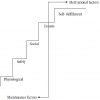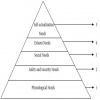Management Concepts & Organisational Behaviour - Motivation
Reinforcement Theory - Motivation
Posted On :
Reinforcement theory is based on the concepts of operant conditioning developed initially by the well-known psychologist B.F. Skinner.
Reinforcement
Theory
Reinforcement theory is based on the concepts of operant conditioning developed initially by the well-known psychologist B.F. Skinner. Reinforcement theory argues that the behavior of people is largely determined by its consequences. In other words, those actions that tend to have positive or pleasant consequences tend to be repeated more often in the future, while those actions that tend to have negative or unpleasant consequences are less likely to be repeated again. The reinforcement theory suggests that managers should try to structure the contingencies of rewards and punishments on the job in such a way that the consequences of effective job behaviour are positive while the consequences of ineffective work behaviour are negative or unpleasant. The focus of this approach is
The basic nation underlying
reinforcement theory is concept of reinforcement itself. An event is said to be
reinforcing if the event following
some behaviour makes the behaviour more likely to occur again in the future. It
involves the use of four strategies to systematically reinforce and are
discussed as under:
Positive Reinforcement: It entails the use of rewards (or other positive consequences) that stimulates desired behaviour and strengthens the probability of repeating such behaviour in the future. Positive reinforcers can be money, praise, promotion, recognition, etc.
Negative Reinforcement: This strategy also called “avoidance learning”. It implies the use of unpleasant consequences to condition individuals to avoid behaving in undesirable ways. By making unpleasant consequences contingent on undesirable behaviour, individuals learn to systematically change patterns of behaviour. In work environments, training, safety warnings, orientation sessions and counseling help alert employees against negative consequences of undesirable behaviour.
Extinction: There is withdrawal of all forms of reinforcement to remove undesirable behaviour. For instance, a disruptive employee who is punished by his supervisor for his undesirable behaviour may continue the disruptions because of the attention they bring. By ignoring or isolating the disruptive employee, attention is withheld and possibly also the motivation for fighting.
Reinforcement theory is based on the concepts of operant conditioning developed initially by the well-known psychologist B.F. Skinner. Reinforcement theory argues that the behavior of people is largely determined by its consequences. In other words, those actions that tend to have positive or pleasant consequences tend to be repeated more often in the future, while those actions that tend to have negative or unpleasant consequences are less likely to be repeated again. The reinforcement theory suggests that managers should try to structure the contingencies of rewards and punishments on the job in such a way that the consequences of effective job behaviour are positive while the consequences of ineffective work behaviour are negative or unpleasant. The focus of this approach is
Positive Reinforcement: It entails the use of rewards (or other positive consequences) that stimulates desired behaviour and strengthens the probability of repeating such behaviour in the future. Positive reinforcers can be money, praise, promotion, recognition, etc.
Negative Reinforcement: This strategy also called “avoidance learning”. It implies the use of unpleasant consequences to condition individuals to avoid behaving in undesirable ways. By making unpleasant consequences contingent on undesirable behaviour, individuals learn to systematically change patterns of behaviour. In work environments, training, safety warnings, orientation sessions and counseling help alert employees against negative consequences of undesirable behaviour.
Extinction: There is withdrawal of all forms of reinforcement to remove undesirable behaviour. For instance, a disruptive employee who is punished by his supervisor for his undesirable behaviour may continue the disruptions because of the attention they bring. By ignoring or isolating the disruptive employee, attention is withheld and possibly also the motivation for fighting.
Punishment: This tool is used
when an unpleasant or undesirable behaviour needs to be reduced or eliminated.
For example, a worker’s wages may be deducted if the quality of goods produced
is of substandard quality.
Tags : Management Concepts & Organisational Behaviour - Motivation
Last 30 days 824 views














